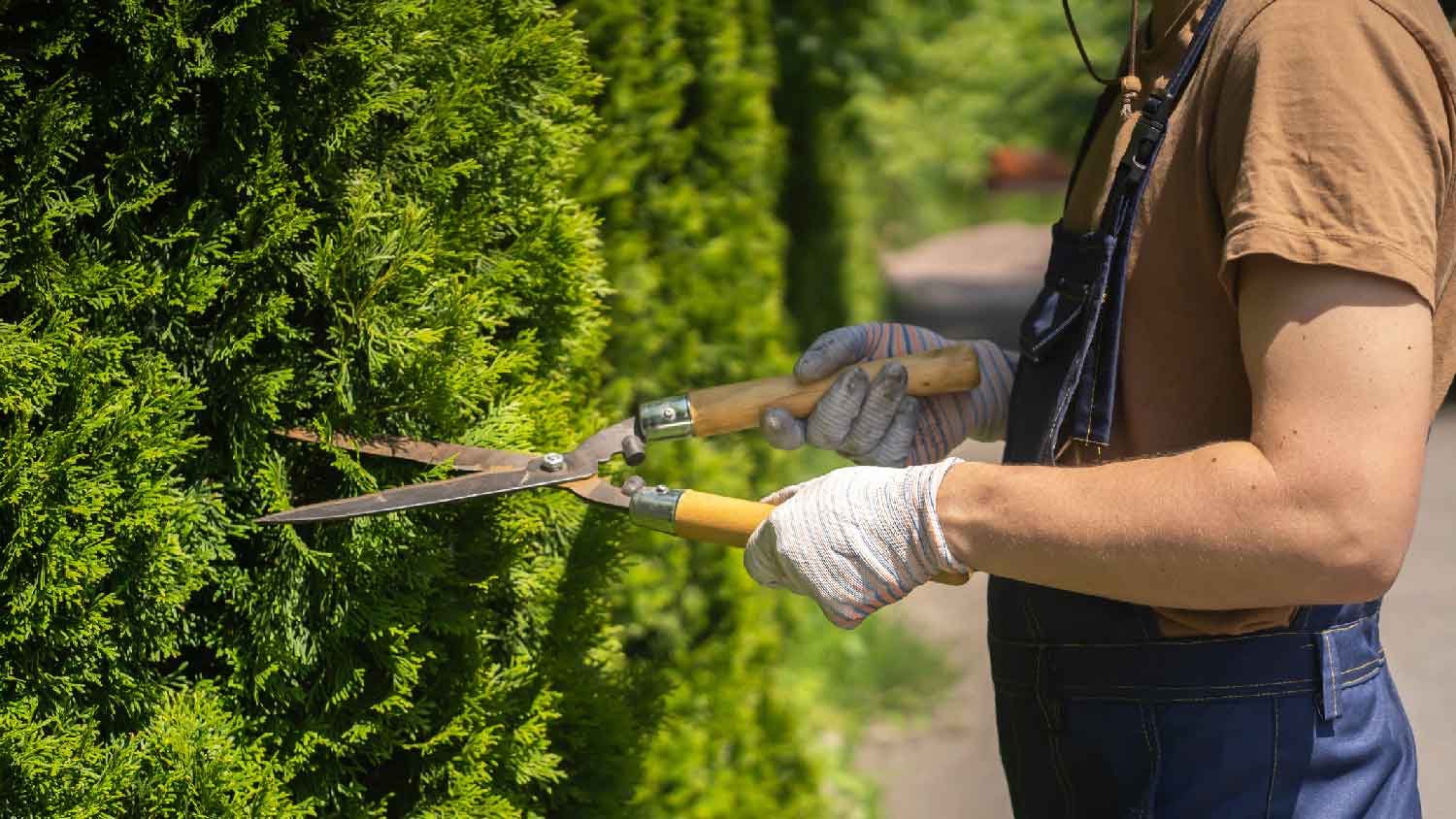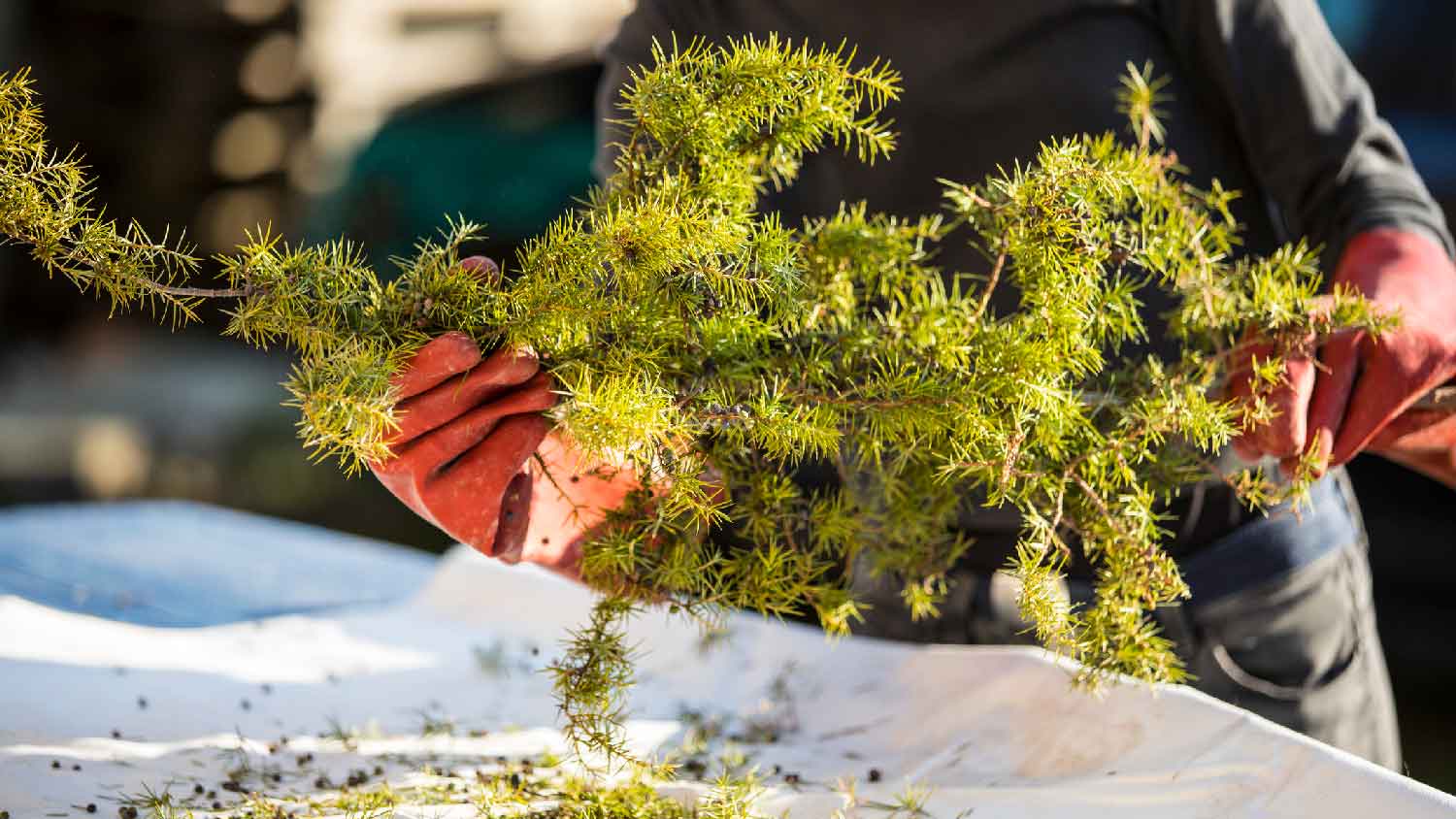.jpg?impolicy=leadImage)
Landscaping your yard adds curb appeal and expands your home’s living space into the outdoors. Learn how much landscaping costs for various projects.
Make room for new landscaping ideas by removing overgrown bushes


Juniper bushes have root systems that can reach over 20 feet underground, which makes removal physically demanding and time-consuming.
Landscaping pros have the specialized tools and equipment to cut through tough juniper roots and remove large stumps.
Junipers tend to grow back from leftover roots, and professionals know how to eliminate root systems to prevent regrowth.
Removing overgrown or large juniper bushes requires proper herbicide application, chainsaw use, and deep excavation.
Hiring a professional landscaping company costs between $450 and $1,375, but it’s a worthwhile investment to avoid spending your weekend on strenuous labor.
Learning how to remove juniper bushes is a lesson in manually force and patience.
Junipers are popular landscaping pine trees that come in several varieties of hardy bushes that grow under many conditions in several climate zones. Junipers make excellent landscaping elements. However, they can easily become overgrown and require removal. Follow these steps to alter your landscaping by removing one or more juniper bushes.
There are a few essential things to know about removing a juniper bush before starting a removal project. First, junipers have massive, deep, and tough root systems. Removing junipers requires dealing with this stubborn root clump, which can take patience and a lot of effort.
The next thing to know is that junipers tend to grow back in the same location, sprouting from roots left in the ground after removing a bush. Eliminating as many roots as possible when removing junipers is essential to keep them from returning. After juniper removal, vigilance will be necessary to watch for sprouts and deal with them quickly after they appear.
While juniper bushes can be lovely and delicate-looking landscaping elements, they're also very strong plants with rigid branches that can scrape or cut those who try to handle them up close. Like preparing to remove a thorn bush, wear appropriate clothing and boots, safety glasses, and heavy-duty work gloves when removing a juniper bush from the ground. If you need to remove a stubborn bush or multiple bushes, consider hiring a professional landscaping team to tackle this task instead.
Arcadia has been an incredible help in getting my yard ready for winter. They recently handled my fall cleanup, tackling everything from leaf removal to trimming and preparing the garden beds. The attention to detail was outstanding—they left everything clean and well-cared for. They also gave great advice on maintaining my garden through winter and preparing for spring. For example, they helped protect my hydrangeas to ensure a full bloom next year and showed me how to winterize my new fig tree which was a gift by wrapping it to shield it from the cold. They even suggested replacing my old habit of tilling my garden beds with mulching to protect the soil from erosion and adds nutrients. If you're looking for a team that goes above and beyond and really knows their stuff, I highly recommend Arcadia!

Removing junipers requires patience. While heavy machinery could quickly remove most of a juniper bush, eliminating the plant entirely and permanently takes time.
To successfully tackle the problem of deep roots when removing a juniper, killing the plant and its roots is crucial. This process starts well before the actual removal. Killing the bush first kills the roots, making them easier to remove from the ground and less likely to grow again. Use one or more of these killing methods a few weeks before removing the juniper.
Small junipers may die off by simply spraying the entirety of the bush with a chemical herbicide containing glyphosate. Protect nearby plants, people, and animals when using herbicides, and allow at least a week to begin to see results.
An effective method of killing a medium-sized juniper is to cut it down to a stump that's a few inches tall and treat it with chemical herbicide. Wait a few weeks to ensure the roots are dead and starting to dry out before starting the removal process.
You can kill large junipers by using a hatchet or saw to cut a 6-inch wide ring in the bark around the base of the trunk. Remove all the bark within the ring and wait a few weeks for the plant to die and begin to dry out. Treat the bare ring with herbicide to speed the process up.
Cut the juniper bush down with a chainsaw or handsaw, leaving only a stump close to ground level. Use a spade shovel to dig a several-foot diameter circle around the stump, cutting the roots as you go. You may need a lopper or hatchet to cut larger roots.
After excavating the trench about one foot deep, dig underneath the stump while cutting more roots. Continue digging and cutting until the stump loosens from the ground. Use a large pry bar if necessary to help loosen it. When all of the roots are cut or broken, remove the stump from the ground.
While most of the roots are dead, you can help ensure your juniper won't come back by digging out as many leftovers as possible. While you won't be able to dig deep enough to reach many of them, clearing the hole of roots to 18 inches deep is adequate.
There's always a chance that some part of a juniper's root system will live through the removal process and send up a spout or two. Over the next few growing seasons, inspect the area regularly. If you notice a new juniper sprout, pull it out or dig it out below ground level to eliminate it.

The most important thing to remember when removing a juniper bush is to be aware of your personal safety. Here are essential tips for keeping yourself and others free from injury or harm when performing the task.
Always call 811 so the local utility company can perform an underground utility survey before digging on your property. It's the law, and this survey will protect you from injury or expensive utility damage.
Wear protective clothing, including safety glasses, work gloves, and work boots.
Follow the manufacturer's label directions strictly if using herbicide to kill juniper bushes.
When cutting down a tall juniper, ensure the area is clear of people, pets, structures, automobiles, mailboxes, toys or other obstacles.
Always follow proper tool safety guidelines when using any tool to help remove a juniper bush.
Removing a juniper bush as a DIY project can be strenuous, especially when dealing with large or overgrown bushes. While accomplishing the task is undoubtedly possible by avid DIYers, it remains a major undertaking.
If spending your weekend on more enjoyable tasks sounds like a better use of your time, a local landscaping company can manage the job for you. These outdoor pros have the skills, tools, and experience necessary to remove your juniper bush efficiently and effectively.
The cost of removing a bush or shrub is between $450 and $1,375, depending on the plant’s size, type, age, and condition. The price of bush removal is typically based on its height, with 4-foot to 6-foot bushes costing $75 to $150 to remove. When hiring a professional landscaping team to remove juniper bushes, ensure they have experience with that type of plant, and request an estimate based on its size and type.
From average costs to expert advice, get all the answers you need to get your job done.
.jpg?impolicy=leadImage)
Landscaping your yard adds curb appeal and expands your home’s living space into the outdoors. Learn how much landscaping costs for various projects.

Leveling your yard can help with drainage and prevent damage to your home. Learn the cost to level a yard in Dallas, TX and what factors can affect the price.

What are average sod installation prices? Learn how much sod costs in Dallas, TX, based on factors like square footage, land prep, land condition, and more.

While similar, comparing dirt versus soil comes down to what's inside the material, its usefulness, and how it performs, depending on how you intend to use it.

Overseeding your lawn can help fill in sparse areas and grow thick, lush grass without starting over. Find out how to overseed a lawn successfully.

Nothing spruces up your home’s exterior quite like refreshing flower beds and walkways with landscaping materials. Learn what questions to ask about mulch before ordering.